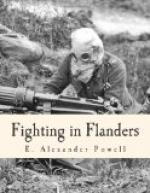The scenes along the highways were even more appalling, for here the retreating soldiery and the fugitive civilians were mixed in inextricable confusion. By mid-afternoon on Wednesday the road from Antwerp to Ghent, a distance of forty miles, was a solid mass of refugees, and the same was true of every road, every lane, every footpath leading in a westerly or a northerly direction. The people fled in motor-cars and in carriages, in delivery-wagons, in moving-vans, in farm-carts, in omnibuses, in vehicles drawn by oxen, by donkeys, even by cows, on horseback, on bicycles, and there were thousands upon thousands afoot. I saw men trundling wheelbarrows piled high with bedding and with their children perched upon the bedding. I saw sturdy young peasants carrying their aged parents in their arms. I saw women of fashion in fur coats and high-heeled shoes staggering along clinging to the rails of the caissons or to the ends of wagons. I saw white-haired men and women grasping the harness of the gun-teams or the stirrup-leathers of the troopers, who, themselves exhausted from many days of fighting, slept in their saddles as they rode. I saw springless farm-wagons literally heaped with wounded soldiers with piteous white faces; the bottoms of the wagons leaked and left a trail of blood behind them. A very old priest, too feeble to walk, was trundled by two young priests in a handcart. A young woman, an expectant mother, was tenderly and anxiously helped on by her husband. One of the saddest features of all this dreadful procession was the soldiers, many of them wounded, and so bent with fatigue from many days of marching and fighting that they could hardly raise their feet. One infantryman who




